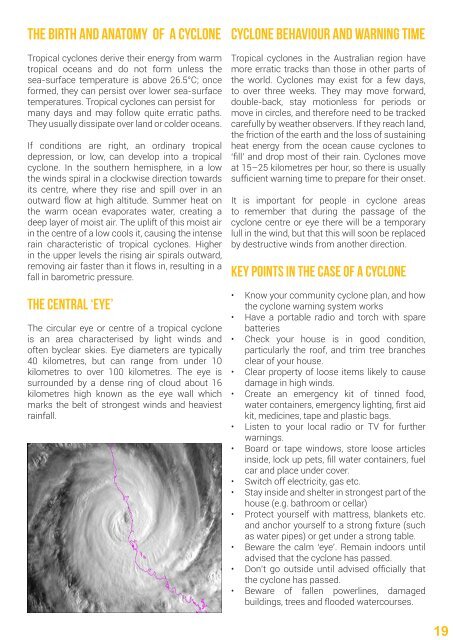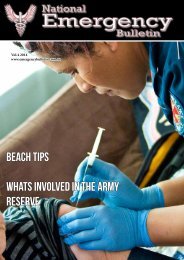Emergency Dispatch Vol 4 2014
You also want an ePaper? Increase the reach of your titles
YUMPU automatically turns print PDFs into web optimized ePapers that Google loves.
19<br />
The Birth and Anatomy of a Cyclone<br />
Tropical cyclones derive their energy from warm<br />
tropical oceans and do not form unless the<br />
sea-surface temperature is above 26.5°C; once<br />
formed, they can persist over lower sea-surface<br />
temperatures. Tropical cyclones can persist for<br />
many days and may follow quite erratic paths.<br />
They usually dissipate over land or colder oceans.<br />
If conditions are right, an ordinary tropical<br />
depression, or low, can develop into a tropical<br />
cyclone. In the southern hemisphere, in a low<br />
the winds spiral in a clockwise direction towards<br />
its centre, where they rise and spill over in an<br />
outward flow at high altitude. Summer heat on<br />
the warm ocean evaporates water, creating a<br />
deep layer of moist air. The uplift of this moist air<br />
in the centre of a low cools it, causing the intense<br />
rain characteristic of tropical cyclones. Higher<br />
in the upper levels the rising air spirals outward,<br />
removing air faster than it flows in, resulting in a<br />
fall in barometric pressure.<br />
The Central ‘Eye’<br />
The circular eye or centre of a tropical cyclone<br />
is an area characterised by light winds and<br />
often byclear skies. Eye diameters are typically<br />
40 kilometres, but can range from under 10<br />
kilometres to over 100 kilometres. The eye is<br />
surrounded by a dense ring of cloud about 16<br />
kilometres high known as the eye wall which<br />
marks the belt of strongest winds and heaviest<br />
rainfall.<br />
Cyclone Behaviour and Warning Time<br />
Tropical cyclones in the Australian region have<br />
more erratic tracks than those in other parts of<br />
the world. Cyclones may exist for a few days,<br />
to over three weeks. They may move forward,<br />
double-back, stay motionless for periods or<br />
move in circles, and therefore need to be tracked<br />
carefully by weather observers. If they reach land,<br />
the friction of the earth and the loss of sustaining<br />
heat energy from the ocean cause cyclones to<br />
‘fill’ and drop most of their rain. Cyclones move<br />
at 15–25 kilometres per hour, so there is usually<br />
sufficient warning time to prepare for their onset.<br />
It is important for people in cyclone areas<br />
to remember that during the passage of the<br />
cyclone centre or eye there will be a temporary<br />
lull in the wind, but that this will soon be replaced<br />
by destructive winds from another direction.<br />
Key Points in the case of a Cyclone<br />
• Know your community cyclone plan, and how<br />
the cyclone warning system works<br />
• Have a portable radio and torch with spare<br />
batteries<br />
• Check your house is in good condition,<br />
particularly the roof, and trim tree branches<br />
clear of your house.<br />
• Clear property of loose items likely to cause<br />
damage in high winds.<br />
• Create an emergency kit of tinned food,<br />
water containers, emergency lighting, first aid<br />
kit, medicines, tape and plastic bags.<br />
• Listen to your local radio or TV for further<br />
warnings.<br />
• Board or tape windows, store loose articles<br />
inside, lock up pets, fill water containers, fuel<br />
car and place under cover.<br />
• Switch off electricity, gas etc.<br />
• Stay inside and shelter in strongest part of the<br />
house (e.g. bathroom or cellar)<br />
• Protect yourself with mattress, blankets etc.<br />
and anchor yourself to a strong fixture (such<br />
as water pipes) or get under a strong table.<br />
• Beware the calm ‘eye’. Remain indoors until<br />
advised that the cyclone has passed.<br />
• Don’t go outside until advised officially that<br />
the cyclone has passed.<br />
• Beware of fallen powerlines, damaged<br />
buildings, trees and flooded watercourses.





